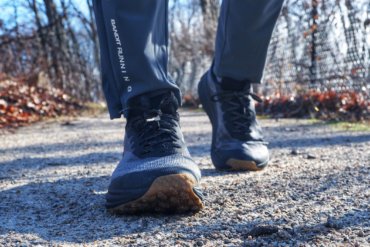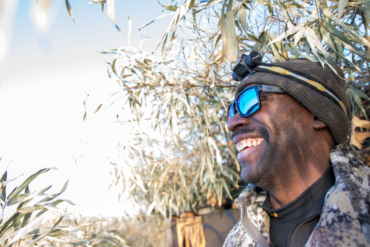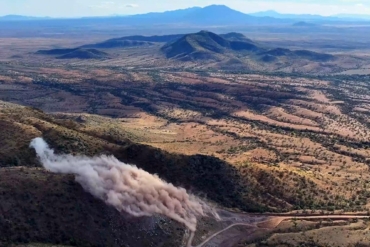
Eyes glued to my fly drifting among the riffles, my feet fluidly move over the underwater terrain. I wade deeper toward the hole.
Time flies when fishing — I look at my watch to see I’ve been in the chilly waters for three hours. But my feet are still warm, and they’ve found confidence navigating the algae-smeared substrate beneath.
Spend any amount of time in a cold trout stream and the first purchase you respect is the wading boot. A good boot keeps the digits warm, protects an ankle from twisting or protruding sharp rocks, and, above all else, gives you traction on slick underlying rock.
Portland-based Korkers introduced the techy Devil’s Canyon Wading Boot this year. I took them out to the Owyhee river for a spin and found they hit all the marks with precision.

The Gear: Korkers Devil’s Canyon Wading Boot ($200); Kling-on and Studded Kling-on, or Kling-on and Plain Felt Sole package (tested).
Available: Now.
Where To Test It: Rocky river streams.
Who’s It For: Fly fisherman who fish long days in the river in multiple states.

OmniTrax sole: To accommodate different river conditions, Korkers developed the Omnitrax interchangeable sole system. It’s easy to use — the sole clips under the toe and into six midsole drainage ports, and then it hooks over a heel pin. To remove the sole, pull the plastic tab off the heel pin and pull the sole toward the toe, out of the clips and off the boot.
The Devil’s Canyon comes with your choice of two sole options (though Korkers offers eight aftermarket accessory soles): rubber/rubber studded or rubber/felt. I used the felt version. Felt provides unparalleled “feel” and traction over slick river stone. But many states are beginning to ban felt soles because the porous felt can host invasive species.
Alaska, Maryland, Missouri, Nebraska, New Jersey, Rhode Island, South Dakota and Vermont all have a statewide bans. So if you live in Virginia but sometimes fish in Maryland, you can simply switch soles. And if one pair wears out, it’s a $30 upgrade.
Design notes: The molded rubber toe-cap and bumper are triple-stitched to the boot, protecting the toes and the boot stitching. A rubber-like upper material provides high ankle support, resists rocky abrasion and dries quickly. The gusseted tongue feeds even the largest neoprene covered piggies into the boot and keeps a river’s till from coming in. The neoprene ankle cuff lets the achilles tendon flex naturally as you hike the long trail into far flung trout streams.

Boa closure: No more soggy laces! The popular Boa closure system (you may have seen these on snowboard boots) has finally made its way into wading boots. The updated M2 system has a 2:1 mechanical advantage, letting you dial up to 50 lbs of torque.

A few quick turns on the Boa knob gives you a snug fit. And getting out of the boot is quick—you pull the knob to release the spool tension and it fully opens up. The M2 has less parts and is sealed to keep the dial debris-free. The exposed wire channels self-clean as they are pulled through tight eyelets. Like all Boa systems, it’s guaranteed for life.
Weight: Super light at under 3 lbs a pair, the Devil’s Canyon is one of the lightest wading boots on the market, making it ideal for fishing streams with long hikes.

Midsole drainage: As you step out of the river, gravity siphons water out the bottom of the boot instead of sloshing out the sides. Three cross-midsole channels funnel water out the three drainage ports exiting on either side of the boot. The boots drained immediately as I stepped out of the stream. I didn’t notice any retained water weight while walking between holes.
Fit: Korkers recommends you size up about a 1/2-size off your street shoe. I’m a 9.5 at the office, 10 in a running shoe, and I got the Devil’s Canyon in a size 10 as well. I was a little nervous about the commodious fit, but it was perfect when paired with a thick wool sock and 3mm neoprene wader.
Made In: China

Awesome! I want to walk among the fish, not swim with the fishes. Korkers’ midsole drainage system keeps the boots from feeling like cement blocks on your feet. Of course, having the option to change soles to match the conditions is a very close second.

Flaw: Boy, it’s tough to find one! The heart can be on the sleeve, but you want the sole stuck to the boot. Still, I found the Omnitrax Sole System hard to remove. Perhaps with time it will loosen up. Another thing: $200 is creeping up toward the high end of the field. If you want a more budget-friendly version, Korkers Whitehourse costs $170 but weighs more.

First Impressions: While $200 is a lot of money, you get a lot of value in this boot including a Boa system, eight different sole options for different river conditions, and a hikeable boot that weighs under three pounds. This reduces environmental impact and keeps the budget down in the long run, a good thing if you have plans for that dream trip to fish Alaska’s Copper River.
Who Should Buy It: Fisherman who travel across state lines to hike and fish in one boot.
Contact Brand/More Beta: Korkers
—Steve Graepel is a contributor. Our “First Look” column highlights new gear arrivals at GearJunkie.com. Photos © Monopoint Media LLC





